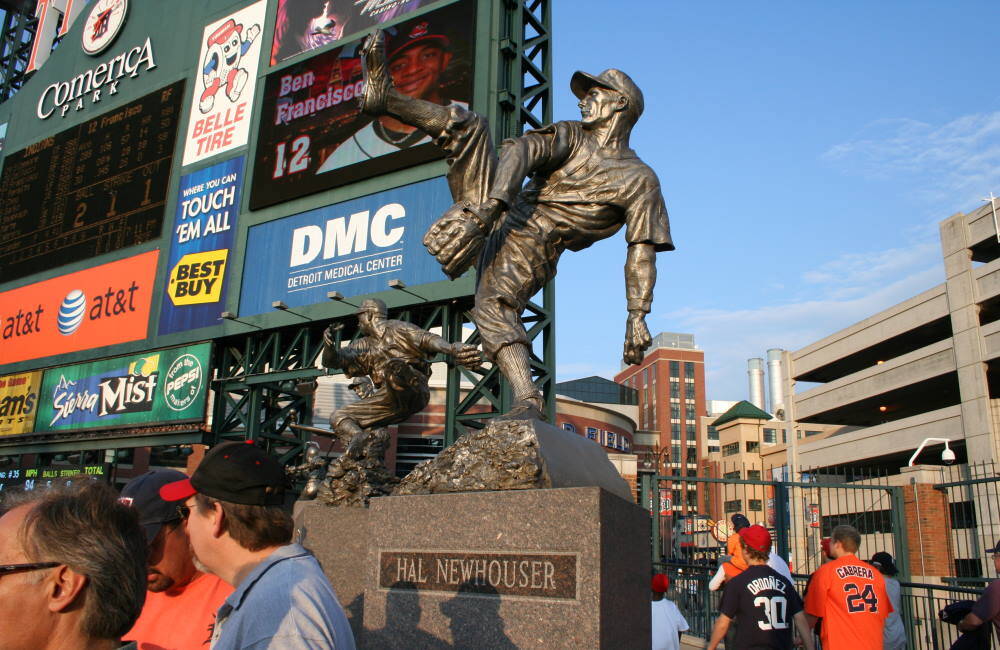Although he retired in 1955, Hal Newhouser remains one of the most famous left-handed pitchers in baseball history. A seven-time All-Star, Newhouser won a World Series with the Detroit Tigers in 1945 and was part of a Cleveland Indians bullpen in 1954 that helped propel the team to an American League pennant.
Fans also remember Newhouser as one of the most cantankerous players of his generation. Known for a fierce temper and a perfectionist’s approach to the game, the pitcher was as hard on himself as he was on other players and opponents. However, he earned the nickname “Prince Hal” for the way he carried himself, always put together.
He’s also notable for going on to become one of the smartest scouts in baseball. In 1992, almost 40 years after retirement and just six years before his death, Newhouser was elected to the Baseball Hall of Fame.
Hal Newhouser’s Early Life
Harold Newhouser was born in Detroit on May 20, 1921. His parents had immigrated to America, His father was from Czechoslovakia, where he had been a gymnast, and his mother came from Austria. His older brother, Dick, had played two years of minor league baseball with the Tigers before quitting after getting hit in the head with a baseball.
Known for always being serious, Newhouser followed in his brother’s footsteps and established a reputation as a good pitcher in his teen year. He became a star at his school, Wilbur Wright High School. Growing up in the Great Depression, Newhouser took odd jobs to help bring in money, including delivering newspapers and setting up pins in a bowling alley.
The Tigers scout Wish Egan signed Newhouser at age 17 by paying him a $500 bonus, a fortune for the family. However, Cleveland Indians scout Cy Slapnicka famously planned to offer the young player $15,000 and a new car, but was late and missed his chance because he had to pick up the car.
Hal Newhouser’s MLB Career
Newhouser spent the first part of the 1939 season in the minors, pitching in Louisiana and then the Texas League. He became known for a killer fastball and a quick temper – so bad that coaches worked on ways to help him keep his emotions in check. The Tigers called him up in September. He started one game, a loss against the Indians. But he struck out four in five innings.
In 1940, Newhouser made the rotation. He was wild, sometimes losing control of his pitches from inning to inning. But when he was on, he was unhittable. He also began to drive teammates crazy, as all he wanted to talk about was pitching. He also threw tantrums when pulled from games, once smashing Coke bottles against the dugout walls.
Newhouser had another hot and cold season in 1942. As America entered World War II after the season, Newhouser got labeled 4-F because doctors discovered a mitrovalve prolapse in his heart.
In 1944, Newhouser came into his own, going 29-9, striking out 187 and getting named MVP. In 1945, he had another MVP season, this time winning 25 games and fanning 212 hitters. The Tigers made the World Series against the Chicago Cubs. Newhouser lost Game 1 but came back to pitch victories in Game 5 and Game 7. In Game 7, he pitched a complete game and struck out 10 batters, leading the Tigers to a world championship.
As a Tiger, Newhouser made the All-Star team from 1942 to 1948. He led the American League in wins from 1944-46, and again in 1948. He slowly became less effective in the late 1940s and early 1950s as arm trouble caught up to him.
By 1952, the Tigers had pulled him from the rotation. After the 1953 season, the team released him. However, Newhouser signed with the Indians and ended up becoming a key pitcher in their bullpen. He was the team’s best long reliever, pitching 46.2 innings and compiling a 7-2 record. The Indians won the American League pennant but lost in the World Series to the New York Giants.
Yankees World Series Wins 1903 - Present
Life After Baseball
Hal Newhouser retired after the 1954 season with a 207-150 record, 3.06 ERA and 1,796 strikeouts. He was elected to the Hall of Fame in 1992.
Although he went on to work 20 years as vice president of a bank in Pontiac, Mich., he wasn’t done with the baseball. He also became a scout, and once again distinguished himself. He worked as a scout for the Indians, Tigers, Baltimore Orioles and Houston Astros. With the Orioles, he discovered Milt Pappas, who went on to achieve 209 wins in the majors. He also discovered Dean Chance, who won the Cy Young in 1964.
As a scout for the Astros, Newhouser also discovered Derek Jeter. But the Astros did not take Newhouser’s recommendation, passing Jeter over in favor of Phil Nevin. Newhouser ended up leaving the Astros shortly afterward.
Newhouser died Nov. 10, 1998, at the age of 77. He was still living in the Detroit area, in Bloomfield Hills, Mich. His family said he had been suffering from emphysema and heart problems.
In an obituary on Newhouser, The New York Times quoted the pitcher as saying this when asked about his philosophy: “Never give up and never give in.”


Leave A Comment